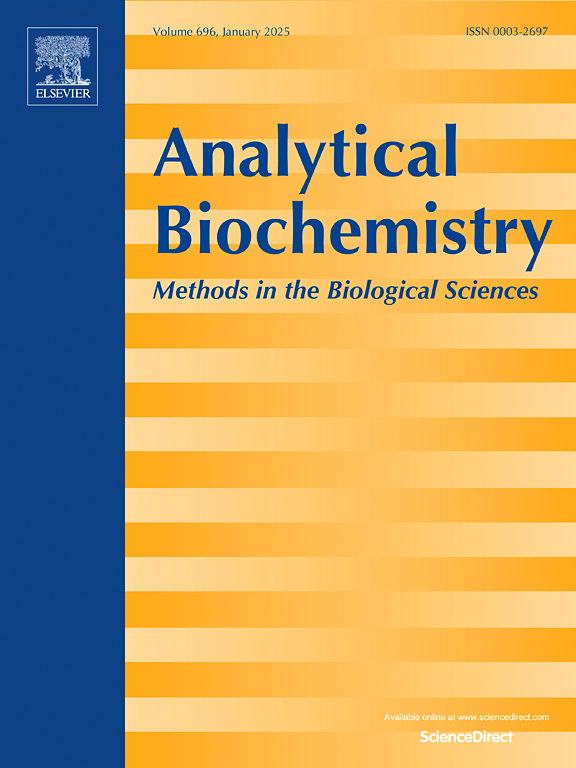脑组织中二磷酸磷脂酰肌醇的富集及MALDI-TOF-MS/MS分析。
IF 2.6
4区 生物学
Q2 BIOCHEMICAL RESEARCH METHODS
引用次数: 0
摘要
采用三唑类α-环糊精click簇-磁性琼脂糖头偶联物(+ cc - mab)在脑组织中富集磷脂酰肌醇二磷酸酯。富集后的样品经磷酸甲基化处理,用MALDI-TOF-MS/MS在正离子模式下进行分析。+ cc - mab能有效去除磷酸肌苷提取物中的弱结合干扰,提高信噪比。MALDI-TOF-MS/MS片段离子显示极性头基的钠加合物,呈现与LC-ESI相反的断裂模式。我们基于+ cc - mab的磷酸肌醇富集方法使MALDI-TOF-MS/MS能够在脑组织中分配38个峰,并鉴定出2个磷脂酰肌醇单磷酸,15个二磷酸和2个三磷酸。据我们所知,这是第一个使用MALDI-TOF-MS/MS特异性PIP富集和磷酸盐甲基化分析脑组织中磷脂酰肌醇二磷酸的研究。本文章由计算机程序翻译,如有差异,请以英文原文为准。

Enrichment and MALDI-TOF-MS/MS analysis of phosphatidylinositol bisphosphates in brain tissue
Triazolium α-cyclodextrin click cluster-magnetic agarose bead conjugate (+CCC-MAB) was used to enrich phosphatidylinositol bisphosphates in brain tissue. The enriched sample was phosphate-methylated and analyzed by MALDI-TOF-MS/MS in positive ion mode. +CCC-MAB effectively removed weak-binding interferences from the phosphoinositide extract and improved the signal-to-noise ratio. The MALDI-TOF-MS/MS fragment ion revealed sodium adducts of polar head groups, exhibiting a converse fragmentation pattern compared to LC-ESI fragmentation. Our +CCC-MAB-based phosphoinositide enrichment method enabled MALDI-TOF-MS/MS to assign 38 peaks in brain tissue and identify two phosphatidylinositol monophosphates, fifteen bisphosphates, and two trisphosphates. To our knowledge, this is the first study to analyze phosphatidylinositol bisphosphates in brain tissue using specific PIP enrichment and phosphate-methylation with MALDI-TOF-MS/MS.
求助全文
通过发布文献求助,成功后即可免费获取论文全文。
去求助
来源期刊

Analytical biochemistry
生物-分析化学
CiteScore
5.70
自引率
0.00%
发文量
283
审稿时长
44 days
期刊介绍:
The journal''s title Analytical Biochemistry: Methods in the Biological Sciences declares its broad scope: methods for the basic biological sciences that include biochemistry, molecular genetics, cell biology, proteomics, immunology, bioinformatics and wherever the frontiers of research take the field.
The emphasis is on methods from the strictly analytical to the more preparative that would include novel approaches to protein purification as well as improvements in cell and organ culture. The actual techniques are equally inclusive ranging from aptamers to zymology.
The journal has been particularly active in:
-Analytical techniques for biological molecules-
Aptamer selection and utilization-
Biosensors-
Chromatography-
Cloning, sequencing and mutagenesis-
Electrochemical methods-
Electrophoresis-
Enzyme characterization methods-
Immunological approaches-
Mass spectrometry of proteins and nucleic acids-
Metabolomics-
Nano level techniques-
Optical spectroscopy in all its forms.
The journal is reluctant to include most drug and strictly clinical studies as there are more suitable publication platforms for these types of papers.
 求助内容:
求助内容: 应助结果提醒方式:
应助结果提醒方式:


